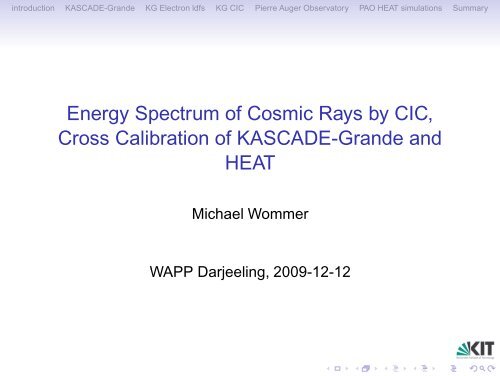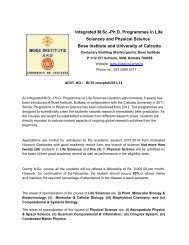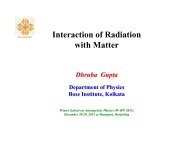Energy Spectrum of Cosmic Rays by CIC, Cross Calibration of ...
Energy Spectrum of Cosmic Rays by CIC, Cross Calibration of ...
Energy Spectrum of Cosmic Rays by CIC, Cross Calibration of ...
You also want an ePaper? Increase the reach of your titles
YUMPU automatically turns print PDFs into web optimized ePapers that Google loves.
introduction KASCADE-Grande KG Electron ldfs KG <strong>CIC</strong> Pierre Auger Observatory PAO HEAT simulations Summary<strong>Energy</strong> <strong>Spectrum</strong> <strong>of</strong> <strong>Cosmic</strong> <strong>Rays</strong> <strong>by</strong> <strong>CIC</strong>,<strong>Cross</strong> <strong>Calibration</strong> <strong>of</strong> KASCADE-Grande andHEATMichael WommerWAPP Darjeeling, 2009-12-12
introduction KASCADE-Grande KG Electron ldfs KG <strong>CIC</strong> Pierre Auger Observatory PAO HEAT simulations SummaryOutlineKASCADE-GrandeKG Electron ldfsKG <strong>CIC</strong>Pierre Auger ObservatoryPAO HEAT simulations
introduction KASCADE-Grande KG Electron ldfs KG <strong>CIC</strong> Pierre Auger Observatory PAO HEAT simulations Summarymotivation• attain the energy spectrum <strong>of</strong> cosmic rays in the range10 16 -10 18 eV <strong>by</strong> constant intensity cut method• basis: electron size spectrum from KASCADE-Grande• then calibrate N e with energy conversion function fromHEAT data
introduction KASCADE-Grande KG Electron ldfs KG <strong>CIC</strong> Pierre Auger Observatory PAO HEAT simulations SummaryKASCADE-Grande
introduction KASCADE-Grande KG Electron ldfs KG <strong>CIC</strong> Pierre Auger Observatory PAO HEAT simulations SummaryKASCADE-Grandey coordinate [m]1000-100-200-300-400-500-600115 4Grande stations10 91615KASCADE32187614 1312Piccolo stations212220 19 181726 2524 2327333029 2832 31Trigger cell 17(18)3736 3534-700-600 -500 -400 -300 -200 -100 0 100x coordinate [m]• 37 detector stations(former EAS-Topdetectors)• per station 10 m 2 plasticscintillator• mean distance <strong>of</strong> 137 mbetween individual stations• ≈ 250000m 2 <strong>of</strong> sensitivearea• central data aquisitionstation
introduction KASCADE-Grande KG Electron ldfs KG <strong>CIC</strong> Pierre Auger Observatory PAO HEAT simulations SummaryKASCADE-Grandey coordinate [m]1000-100-200-300-400-500-600115 4Grande stations10 91615KASCADE32187614 1312Piccolo stations212220 19 181726 2524 2327333029 2832 31Trigger cell 17(18)3736 3534-700-600 -500 -400 -300 -200 -100 0 100x coordinate [m]• 37 detector stations(former EAS-Topdetectors)• per station 10 m 2 plasticscintillator• mean distance <strong>of</strong> 137 mbetween individual stations• ≈ 250000m 2 <strong>of</strong> sensitivearea• central data aquisitionstation
introduction KASCADE-Grande KG Electron ldfs KG <strong>CIC</strong> Pierre Auger Observatory PAO HEAT simulations SummaryKASCADE-Grandey coordinate [m]1000-100-200-300-400-500-600115 4Grande stations10 91615KASCADE32187614 1312Piccolo stations212220 19 181726 2524 2327333029 2832 31Trigger cell 17(18)3736 3534-700-600 -500 -400 -300 -200 -100 0 100x coordinate [m]• 37 detector stations(former EAS-Topdetectors)• per station 10 m 2 plasticscintillator• mean distance <strong>of</strong> 137 mbetween individual stations• ≈ 250000m 2 <strong>of</strong> sensitivearea• central data aquisitionstation
introduction KASCADE-Grande KG Electron ldfs KG <strong>CIC</strong> Pierre Auger Observatory PAO HEAT simulations SummaryKASCADE-Grandey coordinate [m]1000-100-200-300-400-500-600115 4Grande stations10 91615KASCADE32187614 1312Piccolo stations212220 19 181726 2524 2327333029 2832 31Trigger cell 17(18)3736 3534-700-600 -500 -400 -300 -200 -100 0 100x coordinate [m]• 37 detector stations(former EAS-Topdetectors)• per station 10 m 2 plasticscintillator• mean distance <strong>of</strong> 137 mbetween individual stations• ≈ 250000m 2 <strong>of</strong> sensitivearea• central data aquisitionstation
introduction KASCADE-Grande KG Electron ldfs KG <strong>CIC</strong> Pierre Auger Observatory PAO HEAT simulations SummaryKASCADE-Grandey coordinate [m]1000-100-200-300-400-500-600115 4Grande stations10 91615KASCADE32187614 1312Piccolo stations212220 19 181726 2524 2327333029 2832 31Trigger cell 17(18)3736 3534-700-600 -500 -400 -300 -200 -100 0 100x coordinate [m]• 37 detector stations(former EAS-Topdetectors)• per station 10 m 2 plasticscintillator• mean distance <strong>of</strong> 137 mbetween individual stations• ≈ 250000m 2 <strong>of</strong> sensitivearea• central data aquisitionstation
introduction KASCADE-Grande KG Electron ldfs KG <strong>CIC</strong> Pierre Auger Observatory PAO HEAT simulations Summarydetector station• 16 scintillator squares perstation• inner 4 scintillators areequipped with high and lowgain PMTs for measuringhigh densities• every station is connectedto DAQ via fibers for triggerand calibration purposes,also cable connection fordata transfer
introduction KASCADE-Grande KG Electron ldfs KG <strong>CIC</strong> Pierre Auger Observatory PAO HEAT simulations Summarydetector station• 16 scintillator squares perstation• inner 4 scintillators areequipped with high and lowgain PMTs for measuringhigh densities• every station is connectedto DAQ via fibers for triggerand calibration purposes,also cable connection fordata transfer
introduction KASCADE-Grande KG Electron ldfs KG <strong>CIC</strong> Pierre Auger Observatory PAO HEAT simulations Summarydetector station• 16 scintillator squares perstation• inner 4 scintillators areequipped with high and lowgain PMTs for measuringhigh densities• every station is connectedto DAQ via fibers for triggerand calibration purposes,also cable connection fordata transfer
introduction KASCADE-Grande KG Electron ldfs KG <strong>CIC</strong> Pierre Auger Observatory PAO HEAT simulations SummaryDetermination <strong>of</strong> electron sizereconstruction works in several stages• fit <strong>of</strong> Lagutin function to muon densities and NKG tocharged densities• in final step: fit <strong>of</strong> a combined function <strong>of</strong> fixed Lagutin frommuons plus free NKG to charged densities to determineelectron size
introduction KASCADE-Grande KG Electron ldfs KG <strong>CIC</strong> Pierre Auger Observatory PAO HEAT simulations Summary°Lateral density <strong>of</strong> Electron size up to 16.7 (qgs_cont-2r-x, Hydrogen)]2electron density [1/m510 H sim, 6.0
introduction KASCADE-Grande KG Electron ldfs KG <strong>CIC</strong> Pierre Auger Observatory PAO HEAT simulations Summary°Lateral density <strong>of</strong> Electron size up to 16.7 (qgs_cont-2r-x, Hydrogen)]2electron density [1/m510 H sim, 6.0
introduction KASCADE-Grande KG Electron ldfs KG <strong>CIC</strong> Pierre Auger Observatory PAO HEAT simulations Summary2. ab, qgs_cont-2r-x, Hydrogen3. ab, qgs_cont-2r-x, Hydrogen]2electron density [1/m51041031021010]2electron density [1/m510410310210101-110-210-310-4100 100 200 300 400 500 600 700 800core distance [m]1-110-210-310-4100 100 200 300 400 500 600 700 800core distance [m]4. ab, qgs_cont-2r-x, Hydrogen5. ab, qgs_cont-2r-x, Hydrogen]2electron density [1/m51041031021010]2electron density [1/m510410310210101-110-210-310-4100 100 200 300 400 500 600 700 800core distance [m]1-110-210-310-4100 100 200 300 400 500 600 700 800core distance [m]
introduction KASCADE-Grande KG Electron ldfs KG <strong>CIC</strong> Pierre Auger Observatory PAO HEAT simulations Summary°Lateral density <strong>of</strong> Electron size up to 16.7 (qgs_cont-2r-x, Iron)]2electron density [1/m510 Fe sim, 6.0
introduction KASCADE-Grande KG Electron ldfs KG <strong>CIC</strong> Pierre Auger Observatory PAO HEAT simulations Summary°Lateral density <strong>of</strong> Electron size up to 16.7 (qgs_cont-2r-x, Iron)]2electron density [1/m510 Fe sim, 6.0
introduction KASCADE-Grande KG Electron ldfs KG <strong>CIC</strong> Pierre Auger Observatory PAO HEAT simulations Summary2. ab, qgs_cont-2r-x, Iron3. ab, qgs_cont-2r-x, Iron]2electron density [1/m51041031021010]2electron density [1/m510410310210101-110-210-310-4100 100 200 300 400 500 600 700 800core distance [m]1-110-210-310-4100 100 200 300 400 500 600 700 800core distance [m]4. ab, qgs_cont-2r-x, Iron5. ab, qgs_cont-2r-x, Iron]2electron density [1/m51041031021010]2electron density [1/m510410310210101-110-210-310-4100 100 200 300 400 500 600 700 800core distance [m]1-110-210-310-4100 100 200 300 400 500 600 700 800core distance [m]
introduction KASCADE-Grande KG Electron ldfs KG <strong>CIC</strong> Pierre Auger Observatory PAO HEAT simulations Summary°Lateral density <strong>of</strong> Electron size up to 16.7 (sel8_V11804, Hydrogen sim)]2electron density [1/m310 H sim, 6.0
introduction KASCADE-Grande KG Electron ldfs KG <strong>CIC</strong> Pierre Auger Observatory PAO HEAT simulations Summary°Lateral density <strong>of</strong> Electron size up to 16.7 (sel8_V11804, Iron sim)]2electron density [1/m310 Fe sim, 6.0
introduction KASCADE-Grande KG Electron ldfs KG <strong>CIC</strong> Pierre Auger Observatory PAO HEAT simulations SummaryZenith angle classificationNo.12345Θ-interval0 ◦ -16.7 ◦16.7 ◦ -24.0 ◦24.0 ◦ -29.9 ◦29.9 ◦ -35.1 ◦35.1 ◦ -40.0 ◦ • in order to perform <strong>CIC</strong> it’svery helpful to have binswith same exposure• division in 5 angularintervals• same acceptance in eachangle bin• 2π · ∫ Θ fΘ isin Θ cosΘdΘ =0.260
introduction KASCADE-Grande KG Electron ldfs KG <strong>CIC</strong> Pierre Auger Observatory PAO HEAT simulations Summarydifferential electron size spectra
introduction KASCADE-Grande KG Electron ldfs KG <strong>CIC</strong> Pierre Auger Observatory PAO HEAT simulations Summaryintegrated electron size spectra
introduction KASCADE-Grande KG Electron ldfs KG <strong>CIC</strong> Pierre Auger Observatory PAO HEAT simulations Summaryintegrated electron size spectra
introduction KASCADE-Grande KG Electron ldfs KG <strong>CIC</strong> Pierre Auger Observatory PAO HEAT simulations Summary
introduction KASCADE-Grande KG Electron ldfs KG <strong>CIC</strong> Pierre Auger Observatory PAO HEAT simulations Summaryattenuation function• angle variable: χ = cos 2 (Θ) − cos 2 (21 ◦ )• attenuation: lg N e = lg Ne 21◦ · (1+ αχ + βχ 2)• lg Ne21◦ <strong>by</strong> 3 parameter fit for each individual flux value• global fit to get α and β• lg N 21◦e =lg N e(1+0.182·χ−0.390·χ 2 )
introduction KASCADE-Grande KG Electron ldfs KG <strong>CIC</strong> Pierre Auger Observatory PAO HEAT simulations Summary
introduction KASCADE-Grande KG Electron ldfs KG <strong>CIC</strong> Pierre Auger Observatory PAO HEAT simulations Summarycorrected electron size spectra
introduction KASCADE-Grande KG Electron ldfs KG <strong>CIC</strong> Pierre Auger Observatory PAO HEAT simulations Summaryenergy conversion with KG simssimulations for 2 nd angular bin
introduction KASCADE-Grande KG Electron ldfs KG <strong>CIC</strong> Pierre Auger Observatory PAO HEAT simulations Summaryenergy conversion with KG sims
introduction KASCADE-Grande KG Electron ldfs KG <strong>CIC</strong> Pierre Auger Observatory PAO HEAT simulations Summaryenergy spectrum]1.5GeV-2s -1 sr -1[m410310Akeno (1992)AGASAFly’s EyeHaverah ParkHIRES-MIAPAO, ICRC09KG Ne <strong>CIC</strong>, 5 prim.KG Ne <strong>CIC</strong>, HKG Ne <strong>CIC</strong>, Fe2.5dI/dE × E21010RUNJOBJACEESokol-2Proton-3EASTOPTibetHegraAkeno (1984)CASA-MIACASA-BLANCADICEGrapes QGSJetGrapes SIBYLLKASCADE210310410510610710810910101011101210E [GeV]
introduction KASCADE-Grande KG Electron ldfs KG <strong>CIC</strong> Pierre Auger Observatory PAO HEAT simulations Summarynew methodcalibrate KG data with HEAT data to avoid shortcomings <strong>of</strong>simulationsbenefits• no need <strong>of</strong> composition assumption• no hadronic interaction model influences the analysis chainassumptions• total isotropy <strong>of</strong> cosmic rays in the concerned energy range
introduction KASCADE-Grande KG Electron ldfs KG <strong>CIC</strong> Pierre Auger Observatory PAO HEAT simulations SummaryPierre Auger ObservatoryCoihuecoLoma Amarilla70[km]605040• hybrid detector, 4fluorescence telescopestations 1600 Cerenkovwater detectorsCent.Camp.Los LeonesLosMorados3020100• central campus inMalargue• area <strong>of</strong> 3000 km 2 inPampa Amarilla
introduction KASCADE-Grande KG Electron ldfs KG <strong>CIC</strong> Pierre Auger Observatory PAO HEAT simulations SummaryPierre Auger ObservatoryCoihuecoLoma Amarilla70[km]605040• hybrid detector, 4fluorescence telescopestations 1600 Cerenkovwater detectorsCent.Camp.Los LeonesLosMorados3020100• central campus inMalargue• area <strong>of</strong> 3000 km 2 inPampa Amarilla
introduction KASCADE-Grande KG Electron ldfs KG <strong>CIC</strong> Pierre Auger Observatory PAO HEAT simulations SummaryLos Leones
introduction KASCADE-Grande KG Electron ldfs KG <strong>CIC</strong> Pierre Auger Observatory PAO HEAT simulations Summaryaerial view
introduction KASCADE-Grande KG Electron ldfs KG <strong>CIC</strong> Pierre Auger Observatory PAO HEAT simulations SummaryHigh Elevation Auger Telescopes• low energy extension <strong>of</strong>PAO• 3 tiltable FD at Coihuecosite• pivot-mounted telescopewith FOV <strong>of</strong> 30 ◦ − 58 ◦ inupward mode
introduction KASCADE-Grande KG Electron ldfs KG <strong>CIC</strong> Pierre Auger Observatory PAO HEAT simulations SummaryHigh Elevation Auger Telescopes• due to the FOV higher inthe atmosphere, sensitivedown to 10 17 eV• → one decade in energyoverlap withKASCADE-Grande
introduction KASCADE-Grande KG Electron ldfs KG <strong>CIC</strong> Pierre Auger Observatory PAO HEAT simulations SummaryCoihueco + HEAT
introduction KASCADE-Grande KG Electron ldfs KG <strong>CIC</strong> Pierre Auger Observatory PAO HEAT simulations SummaryHEAT
introduction KASCADE-Grande KG Electron ldfs KG <strong>CIC</strong> Pierre Auger Observatory PAO HEAT simulations SummaryFD electron size• longitudinal electron size pr<strong>of</strong>ile directly related to dEdXpr<strong>of</strong>ile via < α >[F.Nerling, Astropart. Physics 24(2006)421]• N e determined <strong>by</strong> evaluation <strong>of</strong> GH function at KG depthN e = GH(1023 g 1·cm 2 cos Θ )• usual FD energy→ conversion function
introduction KASCADE-Grande KG Electron ldfs KG <strong>CIC</strong> Pierre Auger Observatory PAO HEAT simulations Summarylongitudinal electron size pr<strong>of</strong>ileN e160014006×10θ=27.4 deg120010008006004002000400 500 600 700 800 900 1000 1100 12002slant depth [g/cm ]
introduction KASCADE-Grande KG Electron ldfs KG <strong>CIC</strong> Pierre Auger Observatory PAO HEAT simulations Summaryenergy conversion, HEAT simulations/GeV)reclg(E109.5HFe92=2.56e-9PeV/g/cm8.58y=3.147+0.731*xy=2.734+0.761*x7.56 6.5 7 7.5 8 8.5 9 9.5 10lg Nrece
introduction KASCADE-Grande KG Electron ldfs KG <strong>CIC</strong> Pierre Auger Observatory PAO HEAT simulations Summaryenergy spectrum]1.5GeVs -1 sr -1410310Akeno (1992)AGASAFly’s EyeHaverah ParkHIRES-MIAPAO, ICRC07KG HEAT sim, HKG HEAT sim, Fe-2[m2.5dI/dE × E21010RUNJOBJACEESokol-2Proton-3EASTOPTibetHegraAkeno (1984)CASA-MIACASA-BLANCADICEGrapes QGSJetGrapes SIBYLLKASCADE1210310410510610710810910101011101210E [GeV]
introduction KASCADE-Grande KG Electron ldfs KG <strong>CIC</strong> Pierre Auger Observatory PAO HEAT simulations SummaryDo the different atmospheric conditions in Argentina andGermany influence the aforementioned variables?To answer this question Conex simulations have beenperformed.
introduction KASCADE-Grande KG Electron ldfs KG <strong>CIC</strong> Pierre Auger Observatory PAO HEAT simulations SummaryConex simulations[T. Bergmann et al., Astropart. Physics 26(2007)420]1d Conex simulations for H and Fe for 2 different atmospheres50000 events in each subsample• USstandard Atmosphere• mean Malargue atmosphere[B.Keilhauer, Astropart. Physics 22(2004)249]
introduction KASCADE-Grande KG Electron ldfs KG <strong>CIC</strong> Pierre Auger Observatory PAO HEAT simulations Summaryelectron size vs. energy (H)energy conversion(H)elg N87.576.565.5US standard atmosphereMalargue atmosphere16 16.5 17 17.5 18lg(E/GeV)
introduction KASCADE-Grande KG Electron ldfs KG <strong>CIC</strong> Pierre Auger Observatory PAO HEAT simulations Summaryelectron size vs. energy (Fe)energy conversion (Fe)elg N87.576.565.5US standard atmosphereMalargue atmosphere16 16.5 17 17.5 18lg(E/GeV)
introduction KASCADE-Grande KG Electron ldfs KG <strong>CIC</strong> Pierre Auger Observatory PAO HEAT simulations Summaryelg N0.20.1elg N0.200.1-0.10-0.2-0.3-0.415.5 16 16.5 17 17.5 18lg(E/GeV)-0.1-0.2-0.315.5 16 16.5 17 17.5 18lg(E/GeV)• residuals hydrogen• residuals iron
introduction KASCADE-Grande KG Electron ldfs KG <strong>CIC</strong> Pierre Auger Observatory PAO HEAT simulations Summaryshortcomings, problems and open questions• reliability <strong>of</strong> GH function, especially in the tail• KG simulations heavy compositionHEAT simulations light compositionto do• investigate systematic uncertainties (distance and energydependent efficiency and exposure)• comparison <strong>of</strong> the same simulated events running throughKG and HEAT simulations• perform unfolding procedure instead <strong>of</strong> linear function forenergy calibration• analyzing HEAT data





